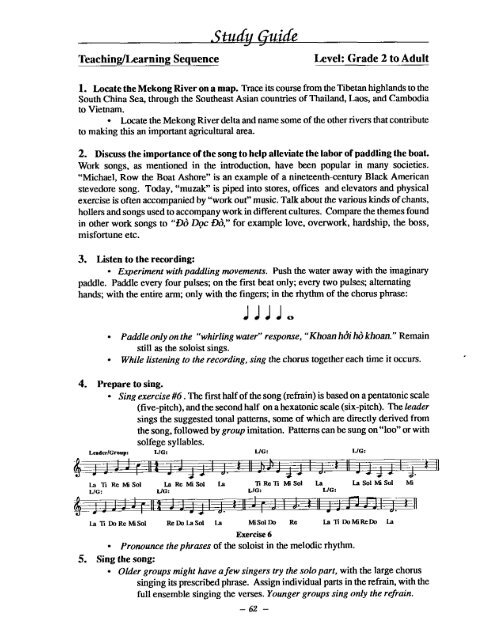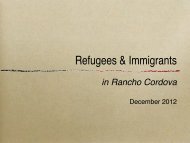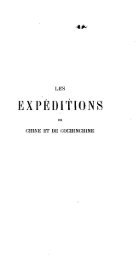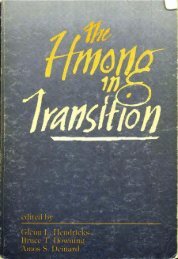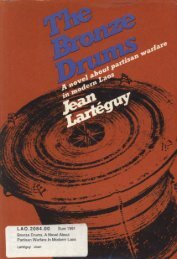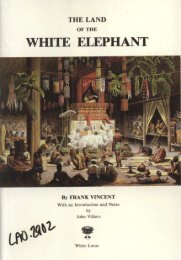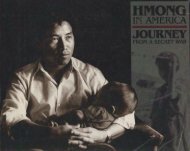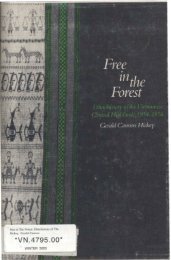and Temple Yards
iutnam From Rice Paddies and Temple Yards - Refugee Educators ...
iutnam From Rice Paddies and Temple Yards - Refugee Educators ...
- No tags were found...
You also want an ePaper? Increase the reach of your titles
YUMPU automatically turns print PDFs into web optimized ePapers that Google loves.
TeachingILearning Sequence<br />
Study Guide<br />
Level: Grade 2 to Adult<br />
1. Locate the Mekong River on a map. Trace its course from the Tibetan highl<strong>and</strong>s to the<br />
South China Sea, through the Southeast Asian countries of Thail<strong>and</strong>, Laos, <strong>and</strong> Cambodia<br />
to Vietnam.<br />
Locate the Mekong River delta <strong>and</strong> name some of the other rivers that contribute<br />
to making this an important agricultural area.<br />
2. Discuss the importance of the song to help alleviate the labor of paddling the boat.<br />
Work songs, as mentioned in the introduction, have been popular in many societies.<br />
"Michael, Row the Boat Ashore" is an example of a nineteenth-century Black American<br />
stevedore song. Today, "muzak" is piped into stores, offices <strong>and</strong> elevators <strong>and</strong> physical<br />
exercise is often accompanied by "work out" music. Talk about the various kinds of chants,<br />
hollers <strong>and</strong> songs used to accompany work in different cultures. Compare the themes found<br />
in other work songs to "D6 Doc Dd," for example love, overwork, hardship, the boss,<br />
misfortune etc.<br />
3. Listen to the recording:<br />
Experiment with paddling movements. Push the water away with the imaginary<br />
paddle. Paddle every four pulses; on the first beat only; every two pulses; alternating<br />
h<strong>and</strong>s; with the entire arm; only with the fingers; in the rhythm of the chorus phrase:<br />
Paddle only on the "whirling water" response, "Khoan h& h6 khoan." Remain<br />
still as the soloist sings.<br />
While listening to the recording, sing the chorus together each time it occurs.<br />
4. Prepare to sing.<br />
Sing exercise #6 . The first half of the song (refrain) is based on a pentatonic scale<br />
(five-pitch), <strong>and</strong> the second half on a hexatonic scale (six-pitch). The leader<br />
sings the suggested tonal patterns, some of which are directly derived from<br />
the song, followed by group imitation. Patterns can be sung on "loo" or with<br />
solfege syllables.<br />
Leadcr/Group: LIG: LIC: LIG:<br />
-<br />
La li Rc Mi Sol La Rc Mi Sol La li RC li Mi Sol La La Sol Mi Sol Mi<br />
LIG: LIG: LIC: LIG:<br />
LaTilhRcMiSol RelhhSol la MiSollk Re La'IFDoMiReaD La<br />
Exercise 6<br />
Pronounce the phrases of the soloist in the melodic rhythm.<br />
5. Sing the song:<br />
Older groups might have a few singers try the solo part, with the large chorus<br />
singing its prescribed phrase. Assign individual parts in the refrain, with the<br />
full ensemble singing the verses. Younger groups sing only the refrain.


